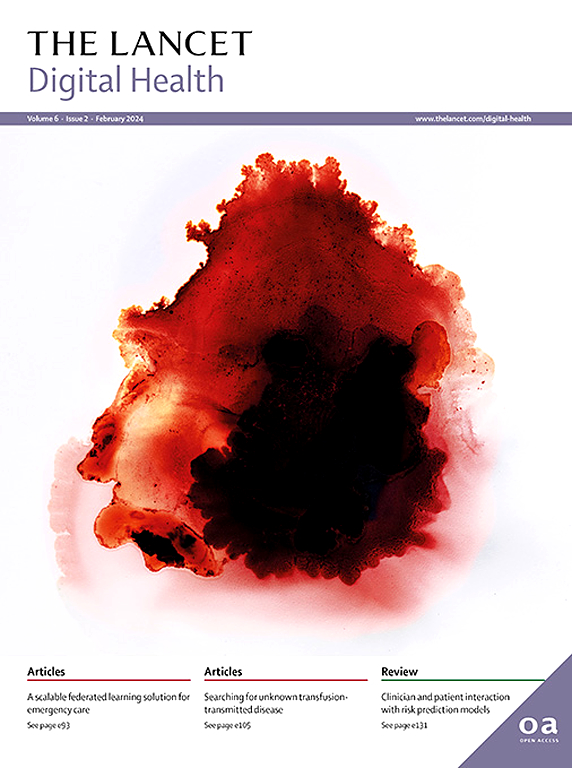FaceAge,一个深度学习系统,从面部照片估计生物年龄,以提高预测:一项模型开发和验证研究。
IF 23.8
1区 医学
Q1 MEDICAL INFORMATICS
引用次数: 0
摘要
背景:随着人类以不同的速度衰老,外表可以比实足年龄更可靠地反映生物年龄和生理健康状况。然而,在医学上,外表以一种主观和非标准化的方式被纳入医学判断。在这项研究中,我们旨在开发和验证FaceAge,这是一个深度学习系统,可以从容易获得的低成本面部照片中估计生物年龄。方法:FaceAge使用来自58 851名60岁或以上的假定健康个体的数据进行训练,其中56 304人来自IMDb-Wiki数据集(训练),2547人来自UTKFace数据集(初始验证)。临床应用评估了来自荷兰和美国两个机构的6196名癌症诊断患者的数据:MAASTRO、哈佛胸廓和哈佛姑息治疗队列。将这些癌症队列的FaceAge估计与535名非癌症参考队列进行比较。为了评估FaceAge的预后相关性,我们进行了Kaplan-Meier生存分析和Cox建模,调整了几个临床协变量。我们还通过将FaceAge纳入临床预测模型,评估了FaceAge在晚期接受姑息治疗的转移性癌症患者中的表现。为了评估FaceAge是否有潜力成为分子衰老的生物标志物,我们进行了一项基于基因的分析,以评估其与衰老基因的关联。结果:FaceAge在不同癌症类型和分期中显示出显著的独立预后表现。年龄越大与总生存率越差相关(在n=4906的泛癌症队列中,校正协变量后,每十年的风险比[HR]为1.151,p= 0.013;1·148,p=0·011在胸部队列n=573;在姑息治疗队列(n=717)中为1·117,p=0·021。我们发现,平均而言,癌症患者看起来比他们的实际年龄要老(与非癌症参考队列相比,平均增加4.79岁)。解释:我们的研究结果表明,深度学习模型可以从面部照片中估计生物年龄,从而提高癌症患者的生存预测。需要进一步的研究,包括在更大的队列中进行验证,以验证癌症患者的这些发现,并确定这些发现是否适用于其他疾病患者。经过进一步的测试和验证,FaceAge等方法可用于将患者的视觉外观转化为客观、定量和有临床价值的测量。资助:美国国立卫生研究院和欧盟欧洲研究理事会。本文章由计算机程序翻译,如有差异,请以英文原文为准。
FaceAge, a deep learning system to estimate biological age from face photographs to improve prognostication: a model development and validation study
Background
As humans age at different rates, physical appearance can yield insights into biological age and physiological health more reliably than chronological age. In medicine, however, appearance is incorporated into medical judgements in a subjective and non-standardised way. In this study, we aimed to develop and validate FaceAge, a deep learning system to estimate biological age from easily obtainable and low-cost face photographs.
Methods
FaceAge was trained on data from 58 851 presumed healthy individuals aged 60 years or older: 56 304 individuals from the IMDb–Wiki dataset (training) and 2547 from the UTKFace dataset (initial validation). Clinical utility was evaluated on data from 6196 patients with cancer diagnoses from two institutions in the Netherlands and the USA: the MAASTRO, Harvard Thoracic, and Harvard Palliative cohorts FaceAge estimates in these cancer cohorts were compared with a non-cancerous reference cohort of 535 individuals. To assess the prognostic relevance of FaceAge, we performed Kaplan–Meier survival analysis and Cox modelling, adjusting for several clinical covariates. We also assessed the performance of FaceAge in patients with metastatic cancer receiving palliative treatment at the end of life by incorporating FaceAge into clinical prediction models. To evaluate whether FaceAge has the potential to be a biomarker for molecular ageing, we performed a gene-based analysis to assess its association with senescence genes.
Findings
FaceAge showed significant independent prognostic performance in various cancer types and stages. Looking older was correlated with worse overall survival (after adjusting for covariates per-decade hazard ratio [HR] 1·151, p=0·013 in a pan-cancer cohort of n=4906; 1·148, p=0·011 in a thoracic cohort of n=573; and 1·117, p=0·021 in a palliative cohort of n=717). We found that, on average, patients with cancer looked older than their chronological age (mean increase of 4·79 years with respect to non-cancerous reference cohort, p<0·0001). We found that FaceAge can improve physicians’ survival predictions in patients with incurable cancer receiving palliative treatments (from area under the curve 0·74 [95% CI 0·70–0·78] to 0·8 [0·76–0·83]; p<0·0001), highlighting the clinical use of the algorithm to support end-of-life decision making. FaceAge was also significantly associated with molecular mechanisms of senescence through gene analysis, whereas age was not.
Interpretation
Our results suggest that a deep learning model can estimate biological age from face photographs and thereby enhance survival prediction in patients with cancer. Further research, including validation in larger cohorts, is needed to verify these findings in patients with cancer and to establish whether the findings extend to patients with other diseases. Subject to further testing and validation, approaches such as FaceAge could be used to translate a patient’s visual appearance into objective, quantitative, and clinically valuable measures.
Funding
US National Institutes of Health and EU European Research Council.
求助全文
通过发布文献求助,成功后即可免费获取论文全文。
去求助
来源期刊

Lancet Digital Health
Multiple-
CiteScore
41.20
自引率
1.60%
发文量
232
审稿时长
13 weeks
期刊介绍:
The Lancet Digital Health publishes important, innovative, and practice-changing research on any topic connected with digital technology in clinical medicine, public health, and global health.
The journal’s open access content crosses subject boundaries, building bridges between health professionals and researchers.By bringing together the most important advances in this multidisciplinary field,The Lancet Digital Health is the most prominent publishing venue in digital health.
We publish a range of content types including Articles,Review, Comment, and Correspondence, contributing to promoting digital technologies in health practice worldwide.
 求助内容:
求助内容: 应助结果提醒方式:
应助结果提醒方式:


